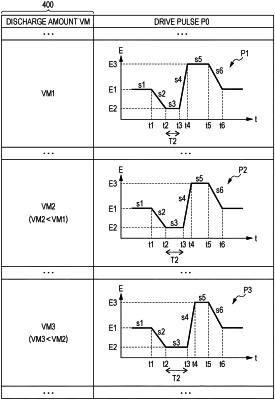| CPC B41J 2/0459 (2013.01) [B41J 2/04558 (2013.01); B41J 2/04581 (2013.01); B41J 2/04588 (2013.01)] | 10 Claims |

|
1. A liquid discharge method of using a liquid discharge head including a drive element and a nozzle to discharge a liquid from the nozzle by applying a drive pulse to the drive element, the method comprising:
an acquisition step of acquiring a recording condition, the recording condition comprising a discharge characteristic and a discharge amount of the liquid from the liquid discharge head is acquired as the recording condition and
a driving step of applying the drive pulse to the drive element, wherein
the drive pulse includes a first potential, a second potential different from the first potential, and a third potential different from the first potential and the second potential, the first potential is a potential between the second potential and the third potential, the second potential being applied after the first potential, and the third potential being applied after the second potential, and
in the driving step,
the drive pulse is applied to the drive element such that a time of the second potential varies depending on the recording condition, a first potential change rate during a change from the first potential to the second potential does not vary depending on the recording condition, and a second potential change rate during a change from the second potential to the third potential does not vary depending on the recording condition,
one drive pulse determined among a plurality of the drive pulses is applied to the drive element, the drive pulses including at least a first drive pulse and a second drive pulse in which the time of the second potential is longer than the time in the first drive pulse,
the first drive pulse is applied to the drive element when the time of the second potential in the second drive pulse is a first time, and the discharge amount acquired in the acquisition step is a first discharge amount,
the second drive pulse is applied to the drive element when the time of the second potential in the second drive pulse is the first time, and the discharge amount acquired in the acquisition step is a second discharge amount smaller than the first discharge amount,
the second drive pulse is applied to the drive element when the time of the second potential in the first drive pulse is a second time which is longer than the first time, and the discharge amount acquired in the acquisition step is the first discharge amount, and
the first drive pulse is applied to the drive element when the time of the second potential in the first drive pulse is the second time, and the discharge amount acquired in the acquisition step is the second discharge amount.
|